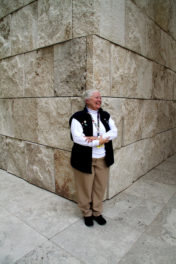
Sounds and Rhythms of Afghanistan: Abbos Kosimov, Homayun Sakhi, Salar Nader, and Humayun Khan
Just 48 hours before he was pounding percussion onstage at the Getty Center this past weekend, one of the creators of Sounds and Rhythms of Afghanistan (S.A.R.A.) was teaching tabla drumming at a music school in Kabul. But the Afghan-American Angelino is used to that commute.
“I feel like an ambassador of music,” said Salar Nader, a 29-year-old composer and co-creator of the cross-cultural ensemble that performed at Sounds of L.A., our free world music concert series. How effective is his diplomacy? Give an audience five minutes with this music, he argues, and they’ll sense the peace and harmony.
The masterful yet easygoing S.A.R.A. ensemble, which also features co-creator/composer Homayun Sakhi on rubab, Abbos Kosimov on doyra, and Humayun Khan on vocals and harmonium, fuses the traditional classical songs of Afghanistan, Uzbekistan, Tajikistan, and North India with their own contemporary percussive stamp. Afghanistan, they say, should be defined by music as much as it is by war.
We captured their warm-up this past Saturday on video—a chance to see their vocal and percussive artistry up close.
Salar’s parents fled the country in 1979 during the Russian-Afghanistan war and settled in Hamburg, Germany—where he was born—before moving to New York. The only toy he cared to play with was the tabla, a set of hand drums of varied sizes and tones. At age 7, he started learning from a master. Now he’s one himself.
Then there’s the ensemble’s other percussive heavyweight. After hearing 10 seconds of his explosive, improvisational playing, I knew it wasn’t wise to get between Abbos and his doyra—see it at 1:21 in the video. A legend in Uzbekistan where he was born, Abbos attacks the ancient frame drum with the power of a karate master.
“Playing is like a narcotic,” said the 40-year-old, who lives in Sacramento and teaches around the world. “If you don’t do it, you don’t feel good.”
The power of Abbos’s drumming pairs perfectly with the mesmerizing vocals of 38-year-old Humayun. The songs he sings, including verses drawn from Sufi poetry, are hypnotic declarations of love and supplications to the divine. Raised in both Afghanistan and Washington, D.C., where his father worked for the World Bank, Humayun was a big fan of Prince, Madonna, and Michael Jackson. But after hearing a famous sitar and tabla player at a concert, he “developed an incredible passion” for Afghan music with its natural rhythms of questions and answers. “We improvise with our voices,” he said, “It’s somewhat like jazz.”
Marrying technique and freestyle play is what Homayun is teaching students in Afghanistan. The Kabul-born musician is both a composer and a virtuoso of the rubab, a short-necked lute that’s the national instrument of Afghanistan.
Homayun and Salar’s trip last week to Kabul included an extended stint at the Afghanistan National Institute of Music (ANIM), which offers children training in Afghan and Western classical music. The beats of the school’s instruments are added to the mix of sounds that surround students, from workday commuters to the din of drone attacks.
“The other day I was in a car and for a second I thought maybe something could explode near us, which is quite scary,” Salar said. Still, working with music students in Afghanistan is more gratifying than getting standing ovations around the globe.
“It’s beautiful working with these children because they’re like a dry sponge, ready for whatever we give them,’’ he said. “I’m in a hurry to go back.”
Next up at Sounds of L.A.—from Kabul, we travel 7,500 miles west to Hawai’i with Keali’i Ceballos and his hulau (hula school). Performances are March 5 and 6, and free reservations are available starting February 24—they go fast!
(video by Steve Saldivar)




Hello,
I have few question about the first picture that’s post on this page where the guys holding Afghan instrument. I have question about those instrument, I really need to talk to you or to those musicians. Please email me back.
Thank you
Yalda
Hi Yalda,
Thanks for commenting. The members of S.A.R.A. are pictured with the following instruments, from left in the photo:
Abbos Kosimov with a doyra (drum), Homayun Sakhi with a rubab (lute), and Salar Nader with a tabla (drum). Humayun Khan is pictured without his harmonium. Hope that helps!
—Annelisa / Iris editor